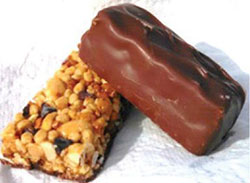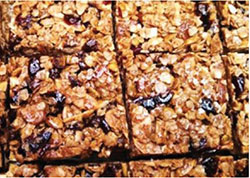Energy Bar or Candy Bar; What’s the Difference?
By: Sheila Gains, Family & Consumer Science Agent, Arapahoe County

The word Energy on the energy bar label means it has a lot of calories. Candy bars also provide energy from calories, so what is the difference? Sometimes there is not much difference; it all depends on the ingredients listed on the label. A balanced energy bar should include a variety of carbohydrates, protein, fiber and healthy fat.
Things to Know and Look For:
Calories: Energy bars pack a lot of calories into a small amount of food. If you are trying to limit your calories, but just want some quick energy or to calm your hunger, they may not be the best choice. A better choice would be a handful of nuts and a small apple. An energy bar might be more appropriate for athletes, who burn lots of calories.
Fat: Some fat is good, because it slows the absorption of energy. This helps avoid a quick burst of energy followed by a quick fall of energy. Some fat also helps you absorb any fat soluble vitamins in the bar. Look for bars that provide less than 30% – 40% of the total calories from fat. Also look for healthy fats like nut oils and read the nutrition label. Avoid all Trans -fats and limit the saturated fat to no more than 10% of the total calories per serving.
Carbohydrates and Fiber: The quick energy boost in the bar comes from carbohydrates. To avoid a blood sugar spike and crash look for a bar with approximately 40% – 50% of the calories from carbohydrates. A combination of simple carbohydrates like sugar, honey etc. and complex carbohydrates like whole grains is best. The simple carbs help with a burst of quick energy. The complex carbs are processed slower by the body, which helps maintain energy longer. Fiber also helps slow absorption so look for a bar that has at least 3 grams of fiber per serving.
Protein: Some protein is good; it helps the body recover from muscle strain and provides a steady source of energy for the body. You can get too much of a good thing with protein, which can be hard on the kidneys. Choose a bar with no more than 20 grams of protein per serving.
Vitamins, minerals, etc.: Many bars are fortified with vitamins and minerals. As long as the fortification does not go over 100 of the recommended daily value and you are not limited by your doctor, these are usually fine.
Taste: Oh and they should taste good, why waste the time, money and calories on a snack that tastes like cardboard, leaves you with a bad aftertaste, is chalky or gritty, or gets stuck in your teeth/braces.
Let’s Talk
Children, especially teens, are attracted to energy bars, believing these candy tasting bars will give them energy to study, help them develop bigger muscles, or if eaten as a meal replacement will help them lose weight. Talk to children and let them know these facts.
- Energy bars won’t make you leaner, smarter, stronger, or faster on their own
- Energy bars are not a substitute for healthy eating and getting enough sleep
- Energy bars can be used as an occasional snack. Be sure you are active enough to burn off the calories
- Energy bars are great to carry as emergency food when you do not have time for a meal, or you forget your lunch, but they are not a good replacement for a balanced meal
- Because the calories and nutrients are so compact in an energy bar, be sure to drink 6-8 oz. of water when eating them.
Recipe for Health:
Homemade Energy Bars
Makes 16 servings

Ingredients:
- 2 cups rolled oats
- ½ cup shelled pumpkin seeds
- 1 cup sliced almonds
- ½ cup ground flax seed
- ½ cup honey
- ¼ cup brown sugar, packed
- 2 Tablespoons butter
- 2 teaspoons vanilla extract
- 1-2 teaspoon(s) cinnamon
- 1 ½ cups dried fruit (cran-raisins, raisins etc.)
- Pinch of salt
- Cooking Spray
Directions:
- Preheat oven to 350 degrees F. Spray a 9 x 9 inch baking pan with cooking spray
- Spread oats, pumpkin seeds, and almonds out onto a cookie sheet. Toast in the oven for 10 minutes, or until golden brown, stirring every 5 minutes.
- Heat honey, brown sugar, butter, vanilla, salt and cinnamon in a saucepan until completely dissolved.
- Remove the oat and nut mixture from the oven and combine with the ground flax seed, dried fruit and sugar & butter mixture.
- Evenly distribute the mixture in the baking pan. Reduce the oven temperature to 300 F and bake 25 minutes.
- Remove from oven and cool. Cut into 16 squares.
Nutrition Facts (per 1/16 pan): Approximately 170 calories, 7 g fat, 4g protein, 6.5 g fiber, 15 g sugar, Total carbohydrates 22.5 g
Recipe Source and Nutrition Facts adapted from: Outdoor Eating: Enjoying Nature the No-Waste Way, Arizona Cooperative Extension, 4/2011.





